The Arctic Convoy Club
of New Zealand

Veterans of the Arctic Convoys 1941 -


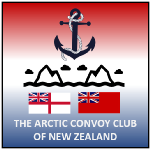
Our Arctic Antics : HMS Bermuda
After the leave which followed passing out from Heron (Yeovilton) I joined as FDO, in early December 1942, the cruiser HMS Bermuda at Scapa Flow. I relieved a Lt Bleasdale, an FDO who had ideas about instituting Headquarters Ships for amphibious landings, and who was off to the Admiralty to pursue these ideas. Bermuda had just returned from the North African landings, where she had taken part in the bombardment of Bone.
The ship had been commissioned in John Browns’ yard at Clydebank on 12th August 1942. She was a Colony Class cruiser – being a follow-
My duties were to be FDO, aircraft recognition officer and air liaison officer as well as quarter-
As fighter direction officer I had my air plot in the bridge structure immediately under the bridge, sharing an office with the surface plot run by the ship’s schoolmaster immediately over my cabin.
The air plot crew consisted at first of myself and about three ratings. We were later joined by Captain Clemenson, Royal Artillery, who had been left in the ship. He had been appointed as FOO (forward observation officer) to liaise with the army in bombardments in the North African campaign – but the army had forgotten him! He was seconded to the air plot for watch-
As speed and accuracy in plotting would be vital in an action, I concentrated from the start on training, with competitions that involved plotting blindfolded from all sides of the plot, so that the crew achieved a very high degree of speed and accuracy in plotting and, when the Fighter Direction School was established at Hatston, the main town in the Orkney Islands we were invited to give demonstrations there.
Ascertaining height of aircraft was in those days difficult and I kept plans of the radar lobes in the plot and checked the first appearance of an echo with the lobe, which proved adequate in practice, though we had to adjust the theoretical lobe with actual calibration runs with aircraft.
We made one or two trips to Iceland, on one of which we tracked aircraft which were obviously German, flying up towards Iceland and back again. I reported this to my captain, who authorised me to go ashore, meet with the Admiral in charge and arrange for land-
Maurice Newman OBE DSC : HMS Bermuda : My Story
Life on Board
The European class system was quite clear aboard RN ships. Generally officers didn’t in any way socialise with the men from the lower deck, partly for discipline reasons, partly because of social class. For New Zealanders who weren’t used to much of a class system at all, this was very different, although people never knew quite where to place us colonials – ‘Black troops’, as some called us.
While I was in training, I considered that the people in charge of the seamen (petty officers and chief petty officers) were without exception absolutely first class and dedicated: it was their life. They were the backbone of the British Navy. After being commissioned, however, I found that the officers in charge were more of a mixed bag. In my case they were mostly RN, and so they were part of this class system. They were all pretty efficient, mostly very English, sometimes cliquey.
We were RNVR, a slightly inferior race – not that we felt it, but there was a difference there all the time. I was lucky in that generally I got on very well with the RN officers, particularly with those on my own level. One junior RN officer, Lt W. J. Woolley, and two RNVR officers, Lt Reg ‘Tiger’ Gilchrist RNVR and Lt D. A. ‘Prof’ Kidd RNVR, became life-
The navy divided the day into watches and everything was done in these watches. There was the forenoon (eight until twelve) the afternoon (twelve until four) the first dog-
There was a good spirit in our wardroom. Every Saturday night in harbour, we had a formal dinner, black ties and all, where we entertained visitors, followed by a social evening of singing and impromptu acts by one or two talented officers.
A new dish to me was kedgeree, which was often served in the wardroom. It consisted of lots of rice and not much fish. Once in northern Iceland a small boat was sent away to do an exercise in dropping small depth charges (designed for dealing with midget submarines). After the depth charges had exploded the boat was filled with the masses of the cod found floating in the water. This cod fed the ship of about 800 men extremely well for a day or so.
My cabin in Bermuda was quite small, about six feet by ten feet. There was a ventilator trunk beside my bunk and sometimes in the northern latitudes I used to wake in the mornings to find a sheet of ice across my top blanket, stretching across from the ventilator. My first job of the day was to clean the ice off the blankets! At one end of the cabin was a cabinet containing a little wash basin, mirror and toilet basin, while opposite my bunk was a narrow writing desk with bookcase above and somehow a chair fitted in below it. This was my home for about 20 months.
From time to time groups of six CW ratings were sent to Bermuda for training, as we had been sent to Lookout. One of these groups consisted of New Zealanders and on one occasion the master of arms, a fearsome looking gentleman, approached me and asked me to speak to one of the New Zealanders who was breaking the censorship rules in his letters home, talking about his duties and where he was, both forbidden. I was impressed that the master of arms did not want an offence to appear on the rating’s record. I duly saw the rating concerned and there was no further difficulty. He was later to become well-
These were the only times we had New Zealanders in our ship’s company apart from me.
I remember in particular the noise of the guns firing, as my cabin was just above and astern of the two forward gun turrets, each with three 6-
Communication between ships at sea was mostly done with flag hoists and signal lamps. Radio silence was normally kept because the Germans did have direction finding, which meant they would be able to locate ships. Various flags had different meanings. There were two or possibly three flags that meant ‘Request permission to proceed in execution of previous orders,’ and the reply would come back either ‘affirmative’ or ‘negative’ on a single flag.
One time when on exercises ‘in line abreast’ on the way back from Russia I could not keep the ship exactly a ‘cable’ (200 yards) from the next ship without creeping ahead or slipping back. The admiral signalled, ‘Bermuda keep station. Hoist the name of the officer of the watch,’ and up went the flags ‘N-
Actually, we had to alter speed in changes of two revolutions of the propeller shafts and our speeds did not quite synchronise with the other ships’. On this occasion the PCO (principal control officer, who was in charge in the event of sudden action until the captain arrived) on the bridge with me had been showing me how to reduce our speed slightly by making tiny alterations of course, then correcting them, which worked perfectly so long as you didn’t look at our wake, which wagged like a dog’s tail. You can’t always win.
Particularly until the fall of Stalingrad, supplying munitions to the Soviet Union by the northern route was essential for their success in fighting the Germans. When we did take part, Bermuda was not part of the close cover for the convoy but was ‘distant cover,’ some 60 miles from the convoy and in some cases, even more remote than that, between the convoy and where large enemy ships might be lurking.
Our first convoy was Convoy JW51B, which sailed on 13 December 1942. The convoy became scattered in a storm off the Faroe Islands and was ordered by the Admiralty to Akureyri, in northern Iceland, to reassemble together with its covering fleet. I believe it was on this trip to Iceland that we located a high mountain on the north-
The convoys had three enemies: U-
For this convoy, the ‘distant cover’ consisted of a force under Rear Admiral Burnett, called Force R, consisting of the cruisers Sheffield and Jamaica and two destroyers. Although our force under Admiral Tovey saw no action, Force R was heavily engaged against the German heavy cruiser Lutzow and the cruiser Hipper. Burnett had raced off to the north-
There was virtually no air-
Duty on the open bridge in the Arctic was a very cold affair, and even the fleece-
Bermuda, preparing to stream paravanes NW of Orkney, following HMS Duke of York and USS South Dakota
HMS Bermuda, November 1943, the official photograph
Our second convoy was JW52, which left Loch Ewe on 17th January 1943 and sailed west of the Faroe Islands with the cruisers Kent, Bermuda and Glasgow providing distant cover under Rear-
We then provided distant cover for the return convoy, RA52, which had only one ship, the American freighter Greylock, torpedoed – by U-
On one of our first Russian convoy patrols (in which we were usually in company with one or two other cruisers and/or battleships), we arrived at Kola Inlet in north Russia in fog and, using the gunnery radar sets and the proximity of the air and surface plots, found our way into our anchorage, while the other ships waited outside until the fog cleared. While not fighter direction, this was, as far as we know, the first instance in which the fighter direction techniques and the link with the surface plot were used in navigation.
When we were able to see the land about us in Kola Inlet it proved to be low-
We spent the summer of 1943 south of Britain – another story.
November 1943 saw us back on northern patrol, covering convoy JW54A, which had sailed from the Minch on 15 November. Our group under Rear Admiral Palliser in Kent and with Jamaica also in company, provided the distant cover. Much of the trip was in mist and cloud, so we went through undetected and were in Kola Inlet by 24 November. I believe it was on this trip that we shipped a load of Russian gold received in part payment for munitions. The security for this operation was prodigious, which did not stop one rating from being ‘up before the captain’ for trying to steal a block of gold as it was being passed from hand to hand along the ship, from the lighter alongside to safe custody in a Bermuda hold. On the return trip we provided distant cover for the returning convoy RA54B. Gales, thick weather and arctic winter once more provided the overcast scud, low visibility and darkness that effectively hid us and the convoy from the airborne eyes of the enemy, and it passed through unscathed, as did we.
Part way to Britain we turned and escorted convoy 54B through the Barents Sea to Russia through the same bad weather. This convoy had sailed nearer the Norwegian coast than usual, with the objective of enticing out the battlecruiser Scharnhorst so that our heavy units could deal with it and remove its menace once and for all. Tirpitz had already been incapacitated by our midget submarines, Lutzow and the cruiser Hipper had been withdrawn from the area after being damaged in the Battle of the Barents Sea, and only Scharnhorst remained a threat.
Routes of the Arctic Convoys (from S. W. Roskill, The Navy at War)
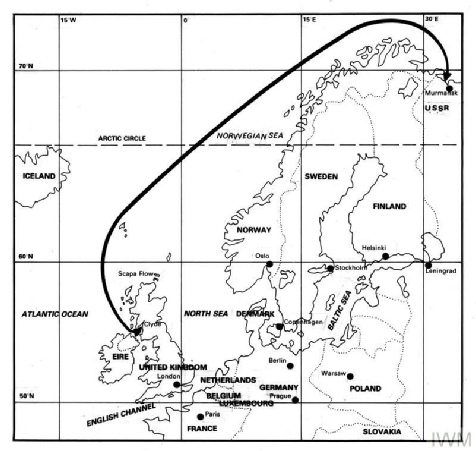
One incident while working out of Scapa Flow taught me something of naval discipline. Two ratings from one of our battleships had been court-
Back in my ship I was working in my cabin when there was a knock on the door. ‘Lieutenant Newman, sir, the commander would like to see you, sir.’ The Commander showed me a signal: ‘To all ships in the Fleet Anchorage, repeated Bermuda: “Personnel in ships’ boats approaching HM ships in the Fleet Anchorage will not make unseemly noises”.’ ‘What is the meaning of this, Newman?’ I told him and was told in no uncertain terms that I should have stopped the noise. Having accepted the reprimand with the proper ‘Ay ay, sir’ I went on to say I was a relatively inexperienced officer and asked how I should have prevented it. ‘Candidly, Newman, I haven’t the foggiest idea.’ ‘Ay ay, sir.’ End of interview: discipline and honour satisfied all round.
Spitzbergen
In May 1943, in company with Cumberland and some destroyers, we took aboard a contingent of Norwegian soldiers and reinforced the garrison at Spitzbergen, 600 miles from the North Pole. They were as fine looking a lot of young men as I had ever seen. They slept in hammocks in our passage-
We were there for about four hours, disembarking men and stores, while our destroyers dashed back and forth across the entrance on U-
On the return trip from Spitzbergen, when the ship was about 80 miles away from a very high Iceland mountain, the ship’s air warning radar started to pick up echoes which I promptly reported to the bridge. The captain immediately brought the ship to ‘repel aircraft stations’. I kept monitoring the echoes and realised they were not moving at all, which was very unusual, so I reported this information to the captain. Eventually the radar officer suggested that it was probably a column of polarised air, of which he had read that it could show on radar. I told the captain over the intercom and, in a rage, he ordered me to the bridge where he asked me exactly what I thought was responsible for the echoes. I replied that the radar officer believed it to be a column of polarised air. At this the captain’s anger subsided and he said, ‘I thought you said polar bears.’ He then proceeded to inform the crew, ‘Relax repel aircraft stations, revert to second degree of readiness. The FDO tells me it’s only a flying polar bear.’
Aurora Borealis
One of the enduring memories of these voyages is that of the ‘Northern Lights’, the Aurora Borealis, which we saw on numerous occasions in the high latitudes if the weather was clear. Imagine yourself on the bridge peering ahead into a dark void and gradually the high sky lightens a fraction, followed by the appearance of dim yellow-
Maurice Newman passed away in Christchurch, New Zealand on Monday 6 April 2009
HMS Bermuda in Akureyri, northern Iceland, February 1944, showing triple turrets.
On the bridge off northern Russia: Capt T.H. Back RN, Lt D.A. Kidd RNVR, Lt Cdr J. Stirling RN
As we in Bermuda lay at anchor in Scapa Flow making ready for the next convoy, Fraser’s ruse of using a convoy (ours) as decoy paid off and in the ensuing Battle of the North Cape, Scharnhorst, out to attack the convoy, was sunk. Sir Robert Burnett, known in the fleet as ‘Bullshit Bob’, was the Admiral commanding the 10th Cruiser Squadron of which we were part. With three cruisers, his flagship Belfast, Norfolk and Jamaica, he played a major part in the battle. On his return to Scapa he came aboard Bermuda and gave an account of the battle to our ship’s company. When he ended he said, ‘I’m only sorry you chaps weren’t with us.’ I heard a rating near me mutter ‘Thank God we weren’t’ – a remark whose significance I never forgot. Many of the ratings were not volunteers but had been conscripted into the navy and felt it was a necessary evil from which they could not escape. Many of them saw no glory in risking life and limb in a war from which they could see no personal benefit. Rhetoric about the Nazi menace did not affect some of them much.
The next convoy, JW56A, which sailed on 12 January 1944, was my last. The weather deteriorated so much that the ships’ cargoes were damaged and the convoy had to reassemble in Akureyri, a fjord in northern Iceland. We discovered an American air force base ashore and arranged to direct some of their anti-
One afternoon when it was Sandeman’s turn to direct the aircraft, Lt Jim Woolley RN and I went ashore to climb a mountainside. We were halfway up when we saw a blizzard approaching across the fjord. We raced down to our caps and jackets, left on a rock, by which time we had small icicles hanging down from our hair. Some US officers warmed us with rum and coke in their officers’ mess, to the extent that I obliged with the Canterbury College haka performed on the bar! Jim Woolley and I kept up our friendship and used to meet every time I went to the UK. Sadly, he died in 2003.
There was a wolf-
On one northern convoy trip a British Conservative member of parliament joined us to experience what happened on such trips. We became friends and at the end of the voyage he offered, if I was interested, to nominate me after the war for the Conservative College, to train to become a Conservative MP. That would have been different again!
Ice on deck. The foc’s’l on arrival in North Russia
Bermuda following HMS Duke of York to Iceland in half a gale, A and B Turrets and the foc’s’l taking the brunt
This website is owned by the Arctic Convoy Club of New Zealand © 2004 -

Maurice Newman passed away on 6 April 2009

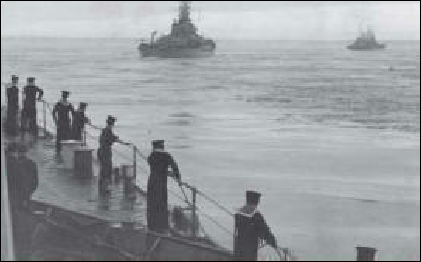
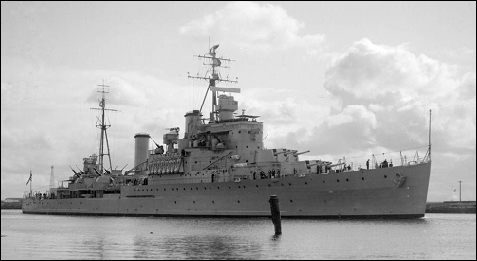
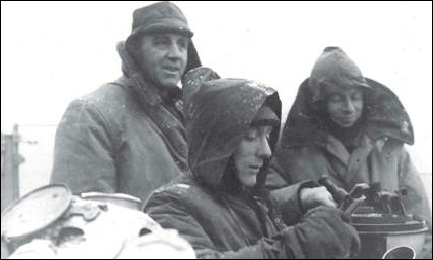
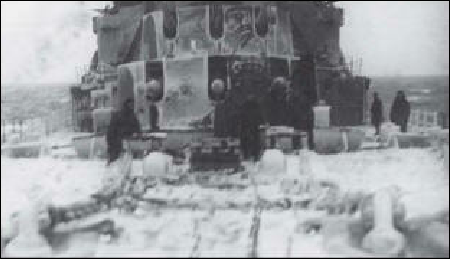
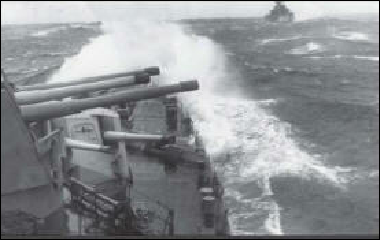
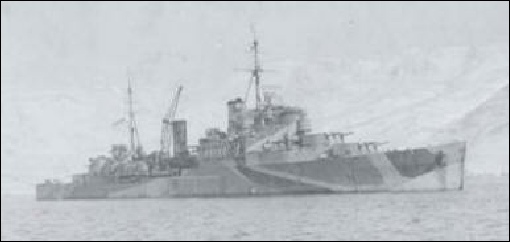
| About Us |
| About Arctic Convoys |
| Convoy Kiwis |
| Greetings Exchange |
| Affiliations |
| Links |
| Topical Items |
| Decorations |
| Membership |
| My Story |
| Newsletter |
| Online Application Convoy Membership |
| Convoy Numbers |
| Merchant Navy Ships |
| Royal Fleet Auxiliary |
| Royal Navy Ships A - B |
| Royal Navy Ships C - F |
| Royal Navy Ships G - L |
| Royal Navy Ships M - O |
| Royal Navy Ships P - T |
| Royal Navy Ships U - Z |
| Obituaries |
| Wellington Memorials |